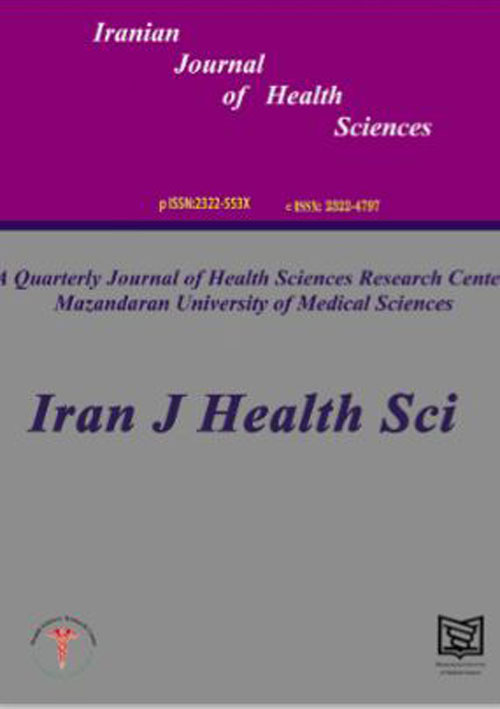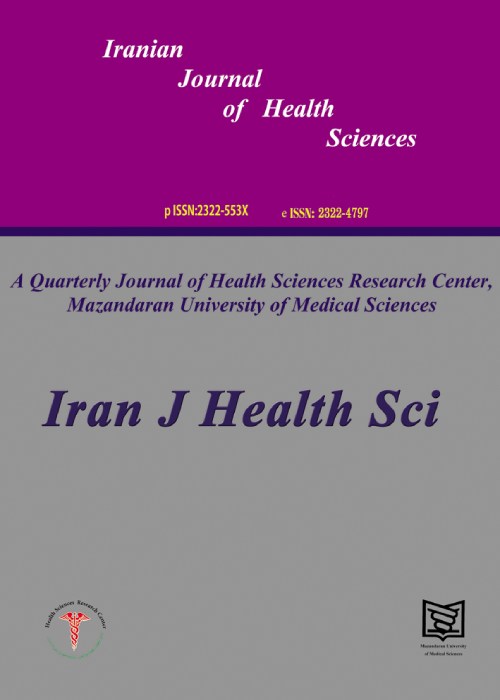فهرست مطالب

Iranian Journal of Health Sciences
Volume:10 Issue: 3, Summer 2022
- تاریخ انتشار: 1401/06/20
- تعداد عناوین: 7
-
-
Pages 1-12Background and Purpose
COVID-19’s proliferation worldwide remains a significant threat to public health; therefore, the assessment and measurement of people’s intentions concerning the prevention of this threat can contribute to the development of suitable educational messages that promote preventive behaviors. This study aimed to develop a questionnaire to determine the factors affecting person’ intention of COVID-19 prevention (FAPI-COP).
Materials and MethodsThis descriptive study was conducted on the people living in Mazandaran Province in 2020. The questionnaire was designed via literature review, focus group discussions, and interview with experts. A total of 10 specialists were selected to determine the content validity scores and 10 Mazandarani laypeople used to determine the reliability of the questionnaire. Finally, content validity index (CVI) and content validity ratio (CVR) were calculated by using Cronbach’s alpha and intraclass correlation coefficient (ICC) in SPSS, version 24.00.
ResultsThe first questionnaire consisted of 51 questions, and after evaluating validity and reliability, 36 questions were obtained. The content validity index of the questionnaire was 0.91, the content validity ratio 0.69, the Cronbach's alpha coefficient 0.78, and the internal correlation coefficient (ICC) 0.95 with the confidence interval of 0.80-0.99.
ConclusionThe results of the study showed that the present questionnaire had acceptable levels of reliability and validity, making it a useful tool in determining the factors affecting intention of COVID-19 prevention by people.
Keywords: Questionnaire Development, Validation, Intention, Prevention, COVID-19 -
Pages 13-23Background and purpose
This study aimed to examine the relationship between the life quality of physically disabled individuals and their social and emotional loneliness.
Materials and MethodsThis study was a cross-sectional type of research in which "Physically Handicapped Life Quality Measurement Tool (WHOQOL-DIS)" was used to determine the quality of life, and "Social and Emotional Loneliness Scale (SELSA)" and “Personal Information Form" were also used to examine the levels of loneliness. The data were collected through face-to-face interviews with 316 people. Pearson Correlation and Multiple Linear Regression analysis were also used to test the relationship between quality of life and loneliness.
Results33.3% of the study group was in the age range of 40-49 and their average age was 41.90 ± 12.86 years. A significant relationship (p<0.05) was documented between the WHOQOL-DIS sub-dimensions and the social and emotional loneliness sub-dimensions. There was also found a weak negative relationship between physical domain and social loneliness, a very weak negative relationship between emotional loneliness and family relationships, a weak negative relationship between the mental domain and social loneliness and loneliness in family relationships, and a very weak relationship in the negative direction with emotional loneliness. It was determined that there was a weak negative relationship between social domain and social loneliness, emotional loneliness and loneliness in family relationships. There was also a weak negative relationship between the environmental domain and social loneliness, emotional loneliness and loneliness in family relationships. The results also showed a moderate negative relationship between the quality of life module and social loneliness, and a weak relationship in the negative direction between emotional loneliness and family relationships.
ConclusionA significant relationship was found between the sub-dimensions of the quality of life scale and the sub-dimensions of the loneliness scale. Also, loneliness was found to be a significant predictor of the quality of life. Any increase in the feeling of loneliness in the lives of disabled people was observed to reduce their quality of life.
Keywords: Physical Disability, Quality of Life, Loneliness -
Pages 24-31Background and Purpose
Several evidences have shown some synergistic effect of diabetes co-morbidity on the tuberculosis (TB) treatment results, while some other studies have not found such associations. This study aimed to investigate the relationship between TB-diabetes co-morbidity and outcomes of TB treatment.
Materials and MethodsThe research population in this case control study were patients with smear positive tuberculosis. The cases were 158 patients with TB and diabetes selected by consensus method, while controls were 316 patients randomly selected from TB patients without diabetes.
ResultsFrequency of unfavorable outcome among cases was higher than among controls (7.6% vs 7.3% respectively, p-value =0.901). Multivariate logistic regression models showed that the odds ratios for adverse treatment outcome, death, treatment failure, positive smear after the intensive phase of treatment and high grade positivity (2+ & 3+) were 0.97(0.45- 2.06), 0.97(0.42-2.24), 0.91(0.17-4.85), 1.39(0.79- 2.44) and 2.57(0.83- 7.92) respectively. Moreover, treatment adverse outcomes among patients with drug complications (22.2% vs. 6.5%, p-value =0.010) and rural residents (10% vs 4.9% respectively, p-value =0.037) were significantly higher than those among patients without complication and urban residents respectively.
ConclusionAlthough we did not observe any significant association between TB-diabetes co-morbidity and treatment results, there was a significant effect measure regarding the effect of smear positivity at the end of the intensive phase of treatment, especially high grade of smear positivity. Because of probable bias in the classification of the exposure, screening of TB patients regarding diabetes mellitus at the beginning of the treatment is recommended.
Keywords: Tuberculosis, Diabetes, Death, Treatment Failure -
Pages 32-43Background and Purpose
This study aimed to estimate the prevalence of sexual behaviors and sexting among students of medical science universities in southeast of Iran by indirect method.
Materials and MethodsIn this cross-sectional study, using a multistage non-random sampling method, we recruited 3900 students from eight universities of medical sciences from Kerman and Sistan and Baluchestan provinces, Iran, in 2019. The data were collected using indirect (NSU: Network Scale-up) methods. Statistical analysis was performed using the Chi-square test.
ResultsOut of 3900 students (mean (SD) age of 22.5 (3.3) years), 48 % were male and 41% were from Sistan and Baluchestan Province. The prevalence of watching porn, masturbation, sexting (text, photo and video), extramarital heterosexual intercourse by nonpayment, sex in return for payment, homosexuality, child abuse (sexual and behavioral), and abortion was 22.6% (95% CI: 21.3 – 24.0), 19.5% (95% CI: 18.2 – 20.7), 8.8% (95% CI: 7.9 – 9.7), 11.7% (95% CI: 10.7 – 12.7), 5.7 (95% CI: 5.0 – 6.5)%, 3.0% (95% CI: 2.5 – 3.5), 0.9% (95% CI: 0.6 – 1.2) and 1.01% (95% CI: 0.7 – 1.3), respectively.
ConclusionAccording to the results, watching porn, masturbation, extramarital heterosexual intercourse by nonpayment and sexting were more common sexual behaviors among university students. Repetition and addiction to these behaviors can harm physical and psychological health of young people especially in Iranian custom, religion and cultural context. Therefore, the youth should be given appropriate training to correctly react to sexual situations.
Keywords: Sexual behaviors, Watching Porn, Masturbation, Sexting -
Pages 44-53Background and Purpose
Emergency Department (ED) staff are frequently faced with road traffic injury victims and also play role as various road users. This study was conducted to investigate the knowledge, attitude, and practices of ED staff towards road safety at referral trauma hospitals of Tabriz.
Materials and MethodsThis cross-sectional study was conducted in 2020 in the referral trauma hospitals of Tabriz. Data were collected using a standard questionnaire. Census sampling was used to select the participants. Descriptive statistics, Pearson’s correlation test and logistic regression model were used for the data analysis using SPSS Software.
ResultsThe mean score of the ED staff in traffic safety knowledge, attitude and practices was 9.73 ± 2.28 out of 15, 95.3±11.4 out of 118, and 61.3±8 out of 76, respectively. The staff’s traffic safety knowledge was associated with their attitude and practices. Moreover, the univariate logistic regression modeling results revealed that participants' traffic safety attitude (OR= 0.96 (95% CI= 0.93-0.99)) and practices (OR= 0.95 (95% CI= 0.91-0.99)) were, independently, correlated with a reduction in road traffic accidents.
ConclusionsThe ED staff’s attitudes towards traffic safety had a positive correlation with their practices and also accident experience. Nonetheless, after adjusting the data in terms of knowledge and attitude, road traffic safety practice was not associated with participants' accident experience. It is crucial to consider road safety education in colleges to promote safety knowledge of graduate individuals which will have conspicuous results in risk reduction.
Keywords: Emergency Department, Traffic Safety, Knowledge, Attitude, Practices -
Pages 54-64Background and purpose
The safety climate refers to employees’ perception of safety which can be affected by job-related stress in the workplace. This study aimed to assess the safety climate and investigate the relationship between job stress factors and safety climate dimensions in a dairy industry.
Materials and MethodsThis was a cross-sectional study. The data was collected using two self-report questionnaires including the Nordic Safety Climate Questionnaire (NOSACQ-50) and the Health and Safety Executive (HSE) indicator tool. After removing the incomplete questionnaires, 164 questionnaires were selected for statistical analysis. Structural Equation Modeling (SEM) was used to investigate the association of the study variables.
ResultsMost job stress factors and all were correlated to the safety climate dimensions. The highest correlation was detected between job stress factors and dimension of management safety priority, commitment, and competence. Among job stress factors, role (r=0.522, P<0.001) and managerial support (r=0.452, P<0.001) had the highest relationship with this dimension. SEM showed job stress had a significant effect on safety climate (B = 0.52, P < 0.001).
ConclusionThe job stress dimensions could be effective in the safety climate. Besides, management and peer support as well as high job demands could decrease stress. Thus, improvement of job stress could promote employees’ safety behaviors and improve their perception of the organization’s safety management system.
Keywords: Dairy Industry, Job Stress, Safety Climate, Structural Equation Modeling -
Pages 65-74Background and Purpose
Covid-19 has infected large proportion of the populaces, and the continuous rise in incidence impelled the declaration of pandemic. The present study expatiated the trends in Covid-19, and explored the significance of immunity and inhabitancy, as well as the possible causes of the pandemic.
Materials and MethodsThis ecological study recruited twenty States enduring gruelling trends in the incidence of Covid-19 by 30 September 2020. Each State was selected using non-random non-probability sampling. Incorporate data excerpted both primary and secondary sources, browsed using PubMed, DOIA, and Google Search Engine. The analysis began by contrasting the healthy life expectancy, against the Covid-19 incidence rate. Following that, the researcher assessed the incidence inconsideration to populaces' immunity and inhabitancy profile. Immunity is determined by general hygiene, food sufficiency, and daily sleep hours. While air pollution, UV-radiations, and temperature attributes inhabitancy. Both immunity and inhabitancy profiles were evaluated by forming clusters. Statistical analysis was performed using SPSS Software, version 16.
ResultThe findings positively associated healthy life expectancy to Covid-19 incidence rate (r=0.02), which meant that the nations indexed high on health profile, and reported high incidence rate. The cluster-1 analysis corroborated the association of nations' hygiene practice (r =-0.34) and food sufficiency (r =-0.08) to a relatively low incidence rate. Whereas, low concentration of air pollution (r=-0.5) in territories played relatively insignificant role in the outbreak and outgrowth of disease. However, cluster-2 observed convincing figures in torrid regions, abided by intense UV-radiation(r=-0.15) and high temperature (r=-0.48). The complete evaluation of data showed the significance of immunity, but failed to manifest relationship considering inhabitancy profile, in low incidence of COVID-19.
ConclusionCOVID-19 trends continue to escalate globally, and nations demonstrate high standing on immunity or inhabitancy profile, frequently falling prey to deadly infection. Thus, they pose ambiguity in associating the exact causations, whether poor health or polluted environment are overall reprehensible for the pandemic disease.
Keywords: Covid-19, Immunity, Inhabitancy


